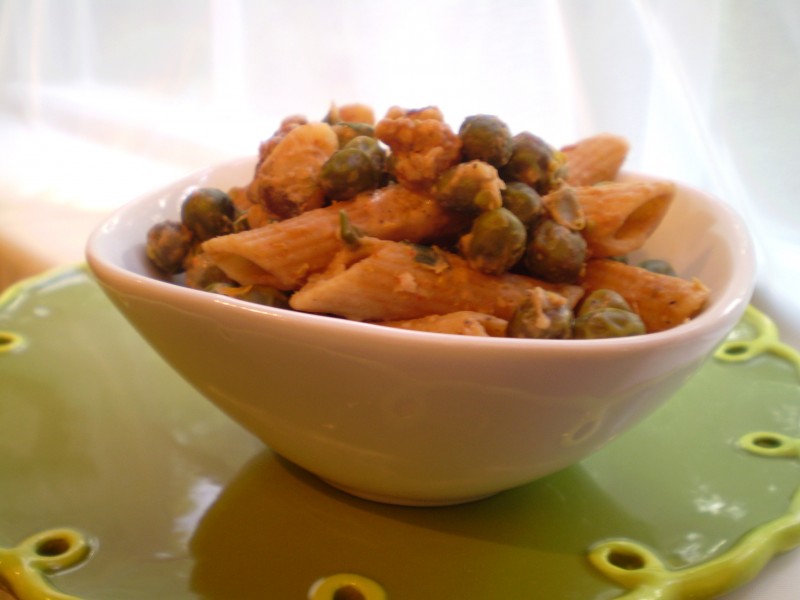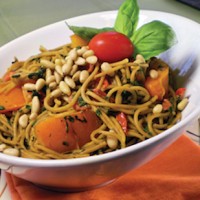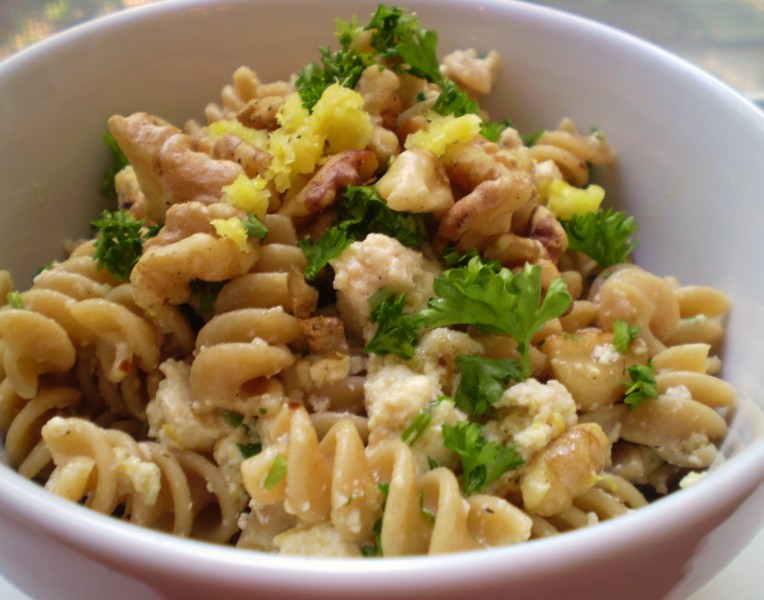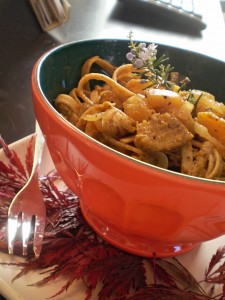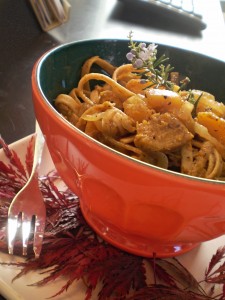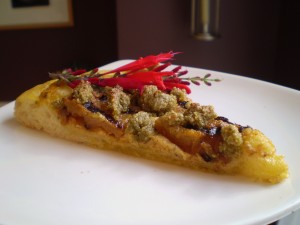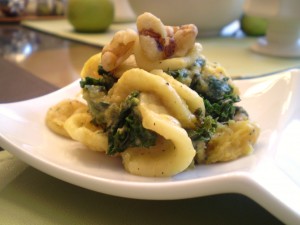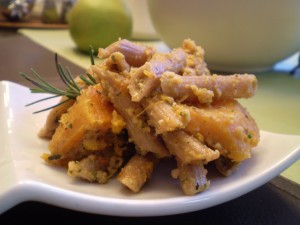 Yield: 2 pizzas/8 servings (2 slices per serving)
Yield: 2 pizzas/8 servings (2 slices per serving)
All things autumn was the inspiration for this absolutely addicting pizza. I’ve enjoyed it three or four times this week and I have not yet had my fill!
Homemade pizza dough is so quick and easy to make that there is scarcely any reason to purchase it, especially since it can be frozen. Hands on prep time is just minutes, but it does take a couple of hours to rise. So, if you are super pressed for time and favor a brand like Trader Joe’s frozen dough, then go for it. If you choose the purchased route, I would definitely recommend a prepared dough as opposed to a prepared crust.
My dough of choice comes from my Blooming Platter Cookbook: A Harvest of Seasonal Vegan Recipes. My recipe calls for a combination of self-rising and whole wheat flours. However, for the pizza pictured, I didn’t have either, so I used all white whole wheat flour with some baking powder. The only difference I found is that it makes a softer dough and, hence, requires additional flour. The crust made this way also benefits from a couple of minutes in the oven before topping it and returning it to the oven to insure that the crust doesn’t become soggy.
Make the dough at least 3 hours before you plan to serve the pizza.
Blooming Platter Pizza Dough
Yield: 2 approximate 8-inch crusts
3/4 cup plus 2 tablespoons self-rising flour (or 3/4 cup plus 2 tablespoons white whole wheat or all purpose flour combined with 1 1/4 teaspoons baking powder and a scant 1/4 teaspoon of sea salt)
3/4 cup plus 2 tablespoons whole wheat flour
Note: you may substitute all white whole wheat or all-purpose flour for both of the above. However, you will need considerably more flour, added 1/4 cup at a time, until dough is smooth and elastic, but slightly sticky.
1 teaspoon “quick rise” yeast
1 teaspoon natural sugar
1 teaspoon sea salt
3/4 cup plus 1 1/2 tablespoons tepid water
2 teaspoons extra virgin olive oil plus 1 teaspoon to oil the bowl
Place all of the dry ingredients in a large bowl, stir to combine, and make a well in the center. Add the water and 2 teaspoons olive oil to the well and stir the wet and dry ingredients together with a fork until fully incorporated.
Knead for 5 minutes with oiled hands or until the dough is smooth and elastic, but slightly sticky. I knead it right in the bowl. Do not over-knead. Lift out the dough and pour the remaining teaspoon of olive oil into the bottom of the bowl and spread to coat the interior with your fingers.
Return the dough to the bowl, rolling it around on both sides to coat with the oil. Cover the bowl loosely with a damp kitchen towel and allow the dough to rise until doubled in bulk, about 2 hours. While the dough rises, prepare the other ingredients.
Next prepare Rosemary-Garlic Olive Oil:
1/4 cup olive oil (makes sure it is super flavorful)
1 5-inch stalk of fresh rosemary
1 clove garlic, thinly sliced
Combine all ingredients in a small cup and set aside.
Prepare the Apple Cider Vinegar Reduction:
1/2 cup apple cider vinegar
2 tablespoon balsamic vinegar
2 tablespoon maple syrup
Pinch sea salt
Combine ingredients in a 1-quart saucepan and simmer over medium-high until reduced to 1/4 cup. Reduce heat if necessary, so that mixture doesn’t scorch. Pour into a small ramekin or cup and set aside.
Before preparing topping, preheat oven to 450 degrees. Place two pizza stones (or two inverted baking sheets) into the oven and heat for 30 minutes.
Caramelized Onion and Apple Topping:
2 tablespoon olive oil
2 medium-large yellow onion, thinly sliced
4 small-medium apples, stemmed, cored, cut into 1/4-inch wedges; cut wedges crosswise into 3 to 4 pieces
Sea salt to taste
1/2 cup Blooming Platter Smokey Cheddar Vegan Cheese Spread
Optional garnish: fresh rosemary sprigs
Heat olive oil in a large cast iron skillet over medium-high heat. Add onion and saute, stirring frequently, for approximately 15 minutes or until onions are beginning to develop a golden color. Reduce heat if necessary to prevent onions from scorching. Add apple, 2 tablespoons of the Apple Cider Vinegar Reduction, and a pinch of salt, and continue sauteing and stirring about 10 minutes, or until onion is deeply colored and apple is tender and has developed some color. Add water, a teaspoon at a time as needed if mixture appears to be drying out. Check for salt and adjust if necessary. Remove the skillet from the heat.
To Assemble:
Remove the rosemary from the olive oil, strip the leaves off the stalk, mince, and set aside.
Lay two 10-inch sheets of aluminum foil, shiny side down, on a work surface. Spray each sheet lightly with non-stick pray. With hands lightly dusted with flour, divide the dough in half, shape each half into a ball, and place one in the center of each piece of foil.
Beginning in the center of the ball and working your way to the edges, use your fingertips and palms to gently press the dough into a circle about 8 1/2 inches in diameter, leaving a slightly raised 1/4-inch wide rim. Brush the entire surface of each very lightly with the Rosemary-Garlic Olive Oil; you will likely have some left over. Lift each piece of foil one at a time, crust and all, holding it taught, and place on one of the baking stones. Bake for 2 minutes. Remove the stones from the oven and divide the onion-apple topping between the two crusts, spreading evenly to the rims. Divide the Cheese Spread between the pizzas, dotting the top of each with teaspoon-size dollops. Sprinkle each with half of the minced rosemary. Return the stones to the oven and cook the pizzas for 9-11 minutes or until the crust is golden and the topping is bubbly, switching the position of the stones halfway through if pizzas seem to be cooking unevenly. Remove the stones from the oven and slide the pizzas, one at a time, onto a cutting board. Drizzle each pizza with 1 tablespoon of the remaining Apple Cider Vinegar and cut each into 8 wedges. Serve immediately garnished with fresh rosemary sprigs.
Note: this pizza reheats beautifully on a pizza stone in a preheated 3350 degree oven for 10 minutes.

